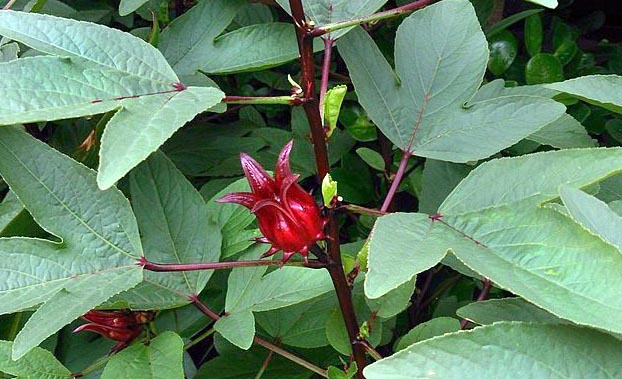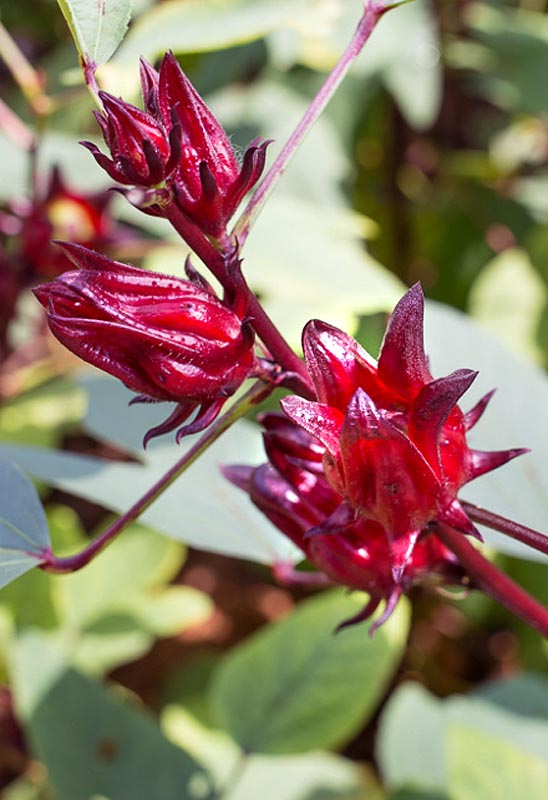A delightful tropical plant that can be grown as an annual in zones up to 6a if given a hot sunny part of the garden. Will grow into large shrub like bush in single summer with large lemon, ivory, slightly pink flowers later in summer. These are followed by bright red calyx the most desired portion of the plant used to create hibiscus tea. It is tart and resembles cranberry in flavour. Needs a long growing season to produce calyx before winter kills the plants. Leaves are also used in many cultures as salad or spinach like greens. Very attractive plant just as a flower can produce annual hedge if desired. Easy to grow but needs water, heat and lots of sunshine.
Flowers arise from each leaf node on a stem and bloom from the bottom upwards. Borne on much shorter stalks that then leaves they nestle amongst the foliage. Each node produces a single bloom but that can be up to 5 inches (12.7cm) across with petals that are eight light pink, yellow or ivory in color. Petals are large wide at the top and slightly ruffled tapering to a deeper cone in the center with the last portion of the petal being a deep red color surrounding a large stout central stigma. Each flower usually lasts only one day and the petals turn darker pink as the day progresses and finally wither with the fading light.
this is when the outer calyx begins to enlarge. Consisting of 5 large sepals and a thin collar of 12 slim bracts around the base it cocoon the base of the flower the gradually enlarges and becomes more fleshy and juicy. It is deep red in color and up to 2.25 inches (5.7cm) in length and fully encloses the velvety seed capsule. This matures to contain 5 separate chambers each with 3-4 kidney shaped light brown seeds.
Plants take a long time to begin flowering starting around mid to late summer and continuing to frost. Calyx for later and mature slowly.
So we always recommend starting seeds indoors in late winter unless you are in zones 10 or warmer. You can wait longer if in zones 8-9 but very early in zones cooler than this.
Seeds are fairly large so sow in individual pots or large cell trays on per cell. Plants need heat to germinate so keep temperatures warm 75-85°F (23-29 C) will not germinate at cooler temperatures. So if your seeds have not grown place them in the warmest place you can find with a dome over them to keep in the heat. Often seeds may germinate late if placed outside once the summer comes and temperatures are hot enough so keep an eye on ungerminated pots/trays.
Use well draining seeding mix and keep moist but not wet throughout, plant about 1/4 inch (cm) deep no more. Germination time will depend on temperature. At warmer temperatures they may sprout within 14 days, if its colder it can take up to a couple of months until the temperatures are warm enough. If kept at a cooler temperature they may never germinate.
If choosing to use a heating pad ensure its on low and pots are monitored constantly for water, heat pads dry out small pots and seeds very quickly and can easily kill germinating seedlings if the dry out.
Transfer to larger pots as the grow and plant out not less than 2 weeks after last frost date to ensure there are no sudden late frosts to kill your plants.
Allow plenty of room. 2-3 feet (61-92cm) between plants in a very sunny hot location. Run a soaker hose between plants so can water regularly at ground level. Mulch around base of plants or use ground cover fabric to suppress weeds are once plants get large its hard to weed under them. If using non porous fabric or plastic ground cover ensure the soaker hose is under the fabric not on top.
Space at about 3-5 feet (1-1.5m) as plants become very large and take up a lot of room. Wider spacing encourages larger plants and larger yields.
They like well drained soil but don't seem fussy about type. Having a reasonable amount of organic material in the soil will help. Ensure you dig this in before planting and make sure its well rotted down. This will reduce the need for feeding over the year but will not remove it entirely.
These plants need quite a bit of water. We recommend laying a soaker hose at the base of the plants close about 2-3 inches but as much as 6 inches (15cm) from the stem. Water a little adding time to the watering each day as the plants grow. may need as much as 20 minutes when 'full grown' which means about 4-5 feet (1.2-1.5m) tall and possibly just as wide.
Mulching around the base of the plants OVER the soaker hose will help keep the water from evaporating and give more use to the plant. It also keeps down the weeds as its hard to weed around them once the plants begin to branch out. Do not put mulches up against the stem of the plant, leave at least 3-4 inches (7.6-10cm) to ensure stems are not attacked by rodents hiding in the mulch.
For zones below 7b getting the plants to flower is not too difficult and enough time should be available to harvest calyx.
zones 7 and 6b are marginal. The plants will flower but often too late to create many calyx that are harvestable before the frost kills the plants. Above this flowering and calyx will not be achieved before frost if plants are grown in the ground.
In these areas plants need to be grown in pots and if possible in a greenhouse. A small inexpensive plastic greenhouse can be enough, just expect them to fill it completely. With experimentation we have found that planted in LARGE pots, meaning something with a diameter of at least 24 inches (61cm) will induce plants to flower earlier than if planted in the ground. Ensure that pots are well spaced and that greenhouse is well ventilated. Leave the doors open during the summer months and only close as the colder weather appears. Adding some form of heat to keep the structure warm overnight will be beneficial as greenhouses loose heat very rapidly at night. Ensure there is still plenty of ventilation during the daytime as if kept closed plants develop mold very quickly and your harvest will be lost.
For those in warmer climates, outdoor planting should produce successful yields and plants may even behave as short lived perennials. Just ensure there is good ventilation to prevent any mold from forming.
Flowers. By this we mean the actual flower with petals NOT the calyx. Almost all teas are made using the calyx NOT the flowers. If you harvest the flowers the calyx will be small as it has not yet developed. If you really want the flower petals we suggest you collect these slightly later in the day after the flower has been pollinated and then remove just the petals. This leaves the calyx to develop for the real tea later on. If the whole flower is removed no calyx will form.
Calyx. For the most part this is the piece of the plant that is most desirable as its used to make hibiscus tea and gives it the characteristic red coloring. Calyx form AFTER the flower has bloomed. They grow and swell getting up to about 1.5 inches (3.7cm) across. Harvest when the calyx is red and fleshy. Calyx ripen from the base of the stem upwards so take care when snipping from the plant. We do not recommend snapping them off unless great care is taken. If you break the stem then the rest of your crop on that stem is now gone.
Calyx ripen later in the season which is why plants need added protection from frost in most areas. Once most of your calyx have been harvested plants can be left to die as they will not survive the winter unless masses of heat are applied or they are brought into the house. They are large and most homes could not accommodate them
Flowers - meaning the petals. Can be used in salads
Calyx. Most commonly used part in western cultures. This red fleshy plant part is also tart and often compared to a cranberry. Its used to make Hibiscus tea, red zinger being the most common but it has a multitude of other uses. Most commonly syrups, jams, jellies or even candied. Various cultures use it for all kinds of desserts and drinks. Strong tea is created by boiling for 20 minutes. In Jamaica it is used to make a alcoholic drink called sorrel. The bright red color from the calyx is often used to color other foods, drinks and desserts. Makes superior lemonade for summer parties and is often used as a substitute for cranberries.
All sources report that home grown calyx are far superior to any bought in stores.
Recently a great deal of research has been done showing that Hibiscus tea can effectively lower blood pressure just as effectively as some blood pressure medications but without the side effects. Research has been conducted in both Africa and Asian has confirmed this, which is excellent for such countries that do not have access to western drugs.
In is native countries of Africa and parts of Asia it is used to treat all kinds of other aliments including abscesses, bilious conditions, cancer, cough, debility, dyspepsia, dysuria, fever, hangover, heart ailments, hypertension, neurosis, scurvy, and arteriosclerosis.







